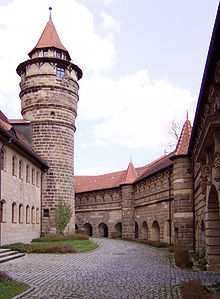Lichtenau Fortress
The Lichtenau Fortress is a former fortification of the Nuremberg castle lords in the market Lichtenau in Middle Franconia .
History of the fortress

The Lichtenau Fortress goes back to a medieval moated castle . In 1406 Nuremberg bought the place and Lichtenau Castle from Friedrich II von Heideck . Due to the location of Lichtenau as a tactical outpost of the imperial city of Nuremberg within the territory of the Margraves of Brandenburg-Ansbach , tensions and destruction during armed conflicts have often occurred in history. For the first time, the imperial city was in possession of a territory in which it also had high jurisdiction and thus sovereignty. Apparently the city council came to the conclusion that it would be better to use someone to cover up in order to avoid disagreements with the burgraves. Part of the area was sold to the “Reiche Almosen”, a foundation of the Nuremberg citizen Burkhard Seiler, while the market, castle and court of Lichtenau were sold to councilor Heinrich Rummel. The Rummel family had made great fortune through long-distance trade; they sat on the city council and spent large private funds on the fortification.
In the First Margrave War in 1449 Albrecht Achilles moved into Lichtenau, devastated the country and conquered the castle, which was only returned in 1453. The margrave claimed sovereignty in the Lichtenau care office, which in turn demonstratively claimed Nuremberg for itself. In 1498, the margrave decided to have a captured culprit executed in Lichtenau, and to do this he called on the castle crew and the farmers in military equipment. The hill north of the village, where the gallows was built, visible from afar, still bears the name Galgenberg today. In the course of the Second Margrave War , the castle was completely destroyed by Albrecht Alcibiades in 1553, although it was surrendered without a fight .
The imperial city of Nuremberg then had a completely new facility built by Wolf Jacob Stromer for a total of 194,000 guilders , probably according to older plans by the builder Antonio Fazzuni . Due to the great destruction, construction dragged on until 1630. Hardly a year later the fortress was besieged by the imperial troops and Georg Scheurl handed the fortress over to the imperial general Tilly , again without resistance, but he did not damage it. The last major attack on the fortress took place in 1688, when the troops of the French "Sun King" Louis XIV attacked it. The French asked the caretaker Johann Friedrich Haller von Hallerstein to hand it over. However, this broke the tradition of surrender without a fight and resisted, whereupon the French broke off the storming.
In 1806 Lichtenau, like Nuremberg and all of Franconia, fell to the Kingdom of Bavaria , after which the fortress was used as a prison. During this time officiated on Lichtenau u. a. Ludwig von Redwitz (1779–1848) as prison director and in 1823 his son Oskar von Redwitz , later known as a poet, was born here.
The fortress Lichtenau is a masterpiece of Renaissance architecture, even if, from a military point of view, at the time of its completion it no longer corresponded to the current developments in fortress construction and, due to its location in the valley, was not easy to defend against siege artillery .
After a thorough renovation, the festival is now used by the Free State of Bavaria as a branch of the Nuremberg State Archives . The inner courtyard and the ramparts can be viewed during the day. Once a year in July, the Heimatverein organizes the castle festival. During this festival, which also attracts young people from the wider region, the castle is open to the citizens for two days.
literature
- Daniel Burger , Birgit Friedel: Castles and palaces in Middle Franconia. ars vivendi Verlag, Cadolzburg 2003, ISBN 3-89716-379-9 , pp. 154–157.
- Günther P. Fehring : City and district of Ansbach (= Bavarian art monuments . Volume 2 ). Deutscher Kunstverlag, Munich 1958, DNB 451224701 , p. 123-126 .
Web links
- Entry on the coat of arms of Fortress Lichtenau in the database of the House of Bavarian History
- Feste Lichtenau (from Burgen-Straße)
- Lichtenau historically
Individual evidence
Coordinates: 49 ° 16 ′ 43 ″ N , 10 ° 41 ′ 13 ″ E



